About Roller Chain and Sprockets
More
ANSI Roller Chain and Links
Connecting links are also known as master links. They're used to join the ends of a chain length. The side plate is easy to remove for attaching to a chain. Adding links are also known as roller links. They require two connecting links to join chain. Adding-and-connecting links are also known as half links and offset links. A combination of connecting and adding links, they join chain that requires an odd number of links. For trade number 35 and up, the side plate is easy to remove for attaching them to chain.
Shock-Absorbing ANSI Roller Chain and Links
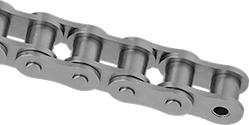



Through-hardened pins keep these chains strong over time while handling frequent jolts from motor startups, emergency braking, and sudden reversing. Use them with wear-resistant sprockets that have hardened teeth.
Connecting links are also known as master links. They're used to join the ends of a chain length. The side plate is easy to remove for attaching to a chain. Adding-and-connecting links are also known as half links and offset links. A combination of connecting and adding links, they join chain that requires an odd number of links.
Corrosion-Resistant ANSI Roller Chain and Links
This 304 stainless steel roller chain is more corrosion resistant than treated steel roller chain.
Connecting links are also known as master links. They're used to join the ends of a chain length. The side plate is easy to remove for attaching to a chain. Adding links are also known as roller links. They require two connecting links to join chain. Adding-and-connecting links are also known as half links and offset links. A combination of connecting and adding links, they can join chain that requires an odd number of links. For trade number 35 and up, the side plate is easy to remove for attaching them to chain.




High-Strength Corrosion-Resistant ANSI Roller Chain and Links
This treated steel chain has over eight times the capacity of stainless steel chain.
Connecting links are also known as master links. They're used to join the ends of a chain length. The side plate is easy to remove for attaching to a chain. Adding links are also known as roller links. They require two connecting links to join chain. Adding-and-connecting links are also known as half links and offset links. A combination of connecting and adding links, they can join chain that requires an odd number of links. The side plate is easy to remove for attaching to chain.
For technical drawings and 3-D models, click on a part number.




| Roller Chain Trade No. | Pitch | Roller Dia. | Roller Wd. | Working Load, lbs. | Each | |
Connecting Links | ||||||
|---|---|---|---|---|---|---|
Corrosion-Resistant-Coated Steel | ||||||
| 60 | 3/4" | 0.469" | 1/2" | 2,450 | 00000000 | 00000 |
Adding Links | ||||||
Corrosion-Resistant-Coated Steel | ||||||
| 60 | 3/4" | 0.469" | 1/2" | 2,450 | 00000000 | 0000 |
Adding-and-Connecting Links | ||||||
Corrosion-Resistant-Coated Steel | ||||||
| 60 | 3/4" | 0.469" | 1/2" | 2,450 | 00000000 | 0000 |
Maintenance-Free ANSI Roller Chain and Links



With oil-embedded bushings and oil-coated pins, this chain is self-lubricating, which means it requires less maintenance than standard ANSI roller chain.
Connecting links are also known as master links. They're used to join the ends of a chain length. The side plate is easy to remove for attaching to a chain. Adding-and-connecting links are also known as half links and offset links. They can join chain that requires an odd number of links. The side plate is easy to remove for attaching to chain.
Extended-Life Maintenance-Free ANSI Roller Chain and Links



A rubber ring seals grease between the bushings and pins and keeps out dust and other contaminants. Because it is self-lubricating, this chain requires less maintenance than standard ANSI roller chain.
Connecting links are also known as master links. They're used to join the ends of a chain length. The side plate is easy to remove for attaching to a chain. Adding-and-connecting links are also known as half links and offset links. They can join chain that requires an odd number of links. The side plate is easy to remove for attaching to chain.
Corrosion-Resistant Maintenance-Free ANSI Roller Chain and Links



This self-lubricating nickel-plated steel chain has better corrosion resistance than steel chain and does not require regular maintenance. It has oil-embedded bushings and oil-coated pins.
Connecting links are also known as master links. They're used to join the ends of a chain length. The side plate is easy to remove for attaching to a chain. Adding-and-connecting links are also known as half links and offset links. They can join chain that requires an odd number of links. The side plate is easy to remove for attaching to chain.
Flat-Edge ANSI Roller Chain and Links
The flat, oblong side plates on this chain make it ideal for conveying items in manufacturing and packaging lines.
Connecting links are also known as master links. They're used to join the ends of a chain length. The side plate is easy to remove for attaching to a chain. Adding links are also known as roller links. They require two connecting links to join chain.
Hollow-Pin ANSI Roller Chain and Links



This steel chain handles higher loads than stainless steel chain. Hollow-pin-style bushings let you add attachments without disassembling the chain.
Connecting links are also known as master links. They're used to join the ends of a chain length. The side plate is easy to remove for attaching to a chain. Adding-and-connecting links are also known as half links and offset links. They can join chain that requires an odd number of links. The side plate is easy to remove for attaching to chain.
ANSI Roller Chain Attachment Links
Add these links to your roller chain to attach brackets or guides, or to move materials directly. Use them for conveying, timing, and aligning. Do not use with Maintenance-Free ANSI Roller Chain.
Connecting links are also known as master links. They're used to join the ends of a chain length. The side plate is easy to remove for attaching to a chain. Adding links are also known as roller links. They require two connecting links to join chain.
Tab links have holes on the tabs for mounting parts and hanging hooks. Pin links have extended pins for tripping switches.


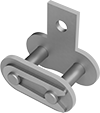
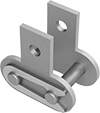


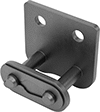
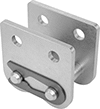
Tab | ||||||
|---|---|---|---|---|---|---|
| Roller Chain Trade No. | Working Load, lbs. | Lg. | Wd. | Mount. Hole Dia. | Each | |
A-1 | ||||||
Steel | ||||||
| 60 | 2,450 | 0.657" | 0.625" | 0.205" | 0000000 | 00000 |
K-1 | ||||||
Steel | ||||||
| 60 | 2,450 | 0.657" | 0.625" | 0.205" | 0000000 | 0000 |
SA-1 | ||||||
Steel | ||||||
| 60 | 2,450 | 0.709" | 0.625" | 0.205" | 0000000 | 0000 |
SK-1 | ||||||
Steel | ||||||
| 60 | 2,450 | 0.709" | 0.625" | 0.205" | 0000000 | 0000 |
WA-2 | ||||||
Steel | ||||||
| 60 | 2,450 | 0.657" | 1.437" | 0.205" | 00000000 | 00000 |
WK-2 | ||||||
Steel | ||||||
| 60 | 2,450 | 0.657" | 1.437" | 0.205" | 00000000 | 00000 |
WSA-2 | ||||||
Steel | ||||||
| 60 | 2,450 | 0.709" | 1.437" | 0.205" | 00000000 | 00000 |
WSK-2 | ||||||
Steel | ||||||
| 60 | 2,450 | 0.709" | 1.437" | 0.205" | 00000000 | 00000 |
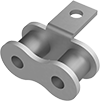

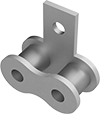
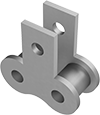
Corrosion-Resistant ANSI Roller Chain Attachment Links
Made of treated steel, these links offer increased corrosion resistance over steel attachment links. Add them to your roller chain to attach brackets or guides, or to move materials directly. Use them for conveying, timing, and aligning. Holes on the tabs allow you to mount parts or hang hooks. Also known as master links, they're used to join the ends of a chain length. The side plate is easy to remove for attaching to a chain. Do not use with Maintenance-Free ANSI Roller Chain.
Tab links have holes on the tabs for mounting parts and hanging hooks. Pin links have extended pins for tripping switches.




| Roller Chain Trade No. | Working Load, lbs. | Tab Lg. | Mount. Hole Dia. | Each | |
A-1 | |||||
|---|---|---|---|---|---|
Corrosion-Resistant-Coated Steel | |||||
| 60 | 2,450 | 0.668" | 0.205" | 0000000 | 00000 |
K-1 | |||||
Corrosion-Resistant-Coated Steel | |||||
| 60 | 2,450 | 0.668" | 0.205" | 0000000 | 0000 |
SA-1 | |||||
Corrosion-Resistant-Coated Steel | |||||
| 60 | 2,450 | 0.733" | 0.205" | 0000000 | 0000 |
SK-1 | |||||
Corrosion-Resistant-Coated Steel | |||||
| 60 | 2,450 | 0.733" | 0.205" | 0000000 | 0000 |
ANSI Roller Chain Spring Clips
Replace lost or damaged spring clips to secure the pins on your connecting links. Face the opening away from the direction of travel to maintain a snug fit.
| For Roller Chain Trade No. | Lg. | Ht. | Pkg. Qty. | Pkg. | |
Steel | |||||
|---|---|---|---|---|---|
| 60 | 1 3/16" | 1/2" | 5 | 0000000 | 00000 |

































